2003 Oldsmobile Alero warning
[x] Cancel search: warningPage 255 of 354

Brake Wear
Your vehicle has four-wheel disc brakes.
Disc brake pads have built-in wear indicators that make
a high-pitched warning sound when the brake pads
are worn and new pads are needed. The sound
may come and go or be heard all the time your vehicle
is moving (except when you are pushing on the
brake pedal firmly).
--
le bra wear warning sound means that
soon your brakes won’t work well. That could
lead to an accident. When you hear the brake
wear warning sound, have your vehicle
serviced.
Notice: Continuing to drive with worn-out brake
pads could result in costly brake repair.
Some driving conditions or climates may cause a brake
squeal when the brakes are first applied or lightly
applied. This does not mean something is wrong with
your brakes. Properly torqued
wheel nuts are necessary to help
prevent brake pulsation. When tires are rotated, inspect
brake pads for wear and evenly tighten wheel nuts in
the proper sequence
to GM torque specifications.
Brake linings should always be replaced as complete
axle sets.
See
Brake System Inspection on page 6-14.
Brake Pedal Travel
See your dealer if the brake pedal does not return to
normal height, or
if there is a rapid increase in
pedal travel. This could be a sign of brake trouble.
Brake Adjustment
Every time you make a moderate brake stop, your disc
brakes adjust for wear.
If you rarely make a moderate
or heavier stop, then your brakes might not adjust
correctly. If you drive in that way, then
- very
carefully
- make a few moderate brake stops about
every
1,000 miles (1 600 km), so your brakes will adjust
properly.
5-40
Page 256 of 354
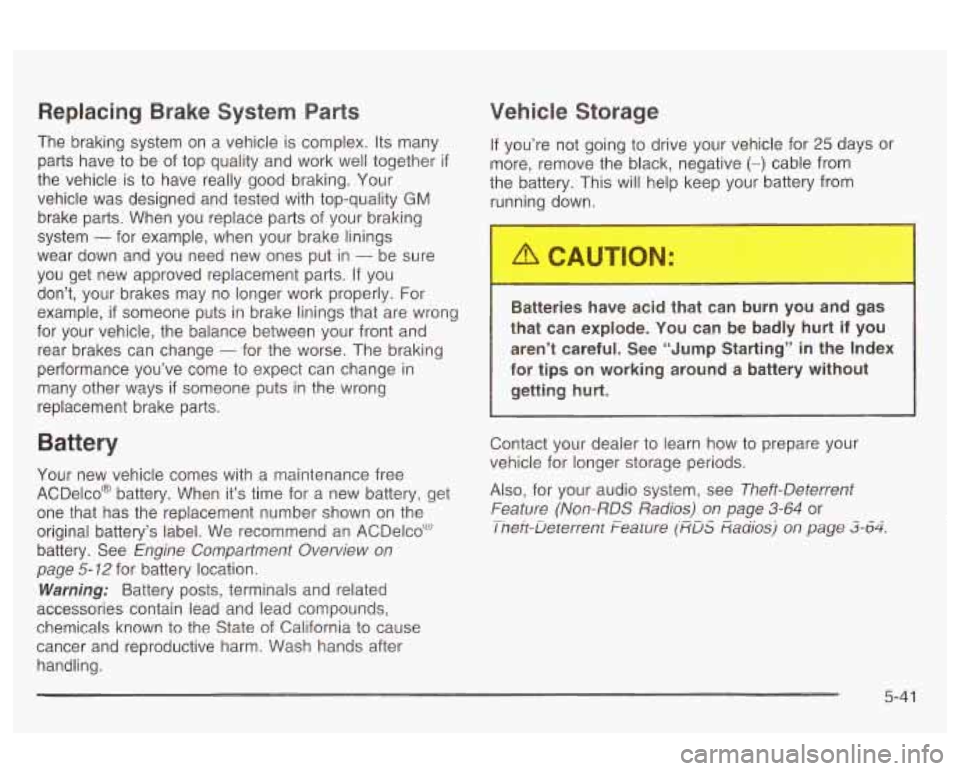
Replacing Brake System Parts
The braking system on a vehicle is complex. Its many
parts have
to be of top quality and work well together if
the vehicle is to have really good braking. Your
vehicle was designed and tested with top-quality
GM
brake parts. When you replace parts of your braking
system
- for example, when your brake linings
wear down and you need new ones put in
- be sure
you get new approved replacement parts. If you
don’t, your brakes may no longer work properly. For
example,
if someone puts in brake linings that are wrong
for your vehicle, the balance between your front and
rear brakes can change
- for the worse. The braking
performance you’ve come
to expect can change in
replacement brake parts.
many other ways if someone puts in the wrong
Battery
Your new vehicle comes with a maintenance free
ACDelco@ battery. When it’s time for a new battery, get
one that has the replacement number shown on the
original battery’s label. We recommend an ACDelcoC”-‘
battery. See
Engine Compartment Overview on
page
5- 12 for battery location.
Warning; Battery posts, terminals and related
accessories contain lead and lead compounds,
chemicals known to the State of California to cause
cancer and reproductive harm. Wash hands after
handling.
Vehicle Storage
If you’re not going to drive your vehicle for 25 days or
more, remove the black, negative
(-) cable from
the battery. This will help keep your battery from
running down.
Batteries have acic bat can burn you and gas
that can explode. You can be badly hurt
if you
aren’t careful. See “Jump Starting” in the Index
for tips
on working around a battery without
I 3--L ’ =
rrnttjqrr hl Irt.
Contact your dealer to learn how to prepare your
vehicle for longer storage periods.
Also, for your audio system, see
Theft-Deterrent
Feature (Non-RDS Radios) on page
3-64 or
I nefi-Deterrent Feature (RDS RaQiosj on page 3-64. -.
5-41
Page 273 of 354

Treadwear
The treadwear grade is a comparative rating based on
the wear rate of the tire when tested under controlled
conditions on a specified government test course.
For example, a tire graded
150 would wear one and
a half
(1.5) times as well on the government course as
a tire graded
100. The relative performance of tires
depends upon the actual conditions of their use,
however, and may depart significantly from the norm
due
to variations in driving habits, service practices and
differences in road characteristics and climate.
Traction - AA, A, B, C
The traction grades, from highest to lowest, are AA, A,
B, and C. Those grades represent the tire’s ability
to stop on wet pavement as measured under controlled
conditions on specified government test surfaces of
asphalt and concrete.
A tire marked C may have poor
traction performance. Warning: The traction grade
assigned
to this tire is based on straight-ahead braking
traction tests, and does not include acceleration,
cornering, hydroplaning, or peak traction characteristics.
Temperature - A, B, C
The temperature grades are A (the highest), B, and C,
representing the tire’s resistance to the generation
of heat and its ability
to dissipate heat when tested
under controlled conditions on a specified indoor
laboratory test wheel. Sustained high temperature can cause
the material of the tire to degenerate and reduce
tire life, and excessive temperature can lead
to
sudden tire failure. The grade C corresponds to a level
of performance which all passenger car tires must
meet under the Federal Motor Vehicle Safety Standard
No. 109. Grades B and A represent higher levels of
performance on the laboratory test wheel than the
minimum required by law.
Warning: The temperature grade for this tire is
established for a tire that is properly inflated and not
overloaded. Excessive speed, underinflation, or
excessive loading, either separately or in combination,
can cause heat buildup and possible tire failure.
Wheel Alignment and Tire Balance
The wheels on your vehicle were aligned and balanced
carefully at the factory
to give you the longest tire life
and best overall performance.
Scheduled wheel alignment and wheel balancing are not needed. However,
if you notice unusual tire wear or
your vehicle pulling one way
or the other, the alignment
may need to be reset. If you notice your vehicle
vibrating when driving on a smooth road, your wheels
may need to be rebalanced.
5-58
Page 277 of 354
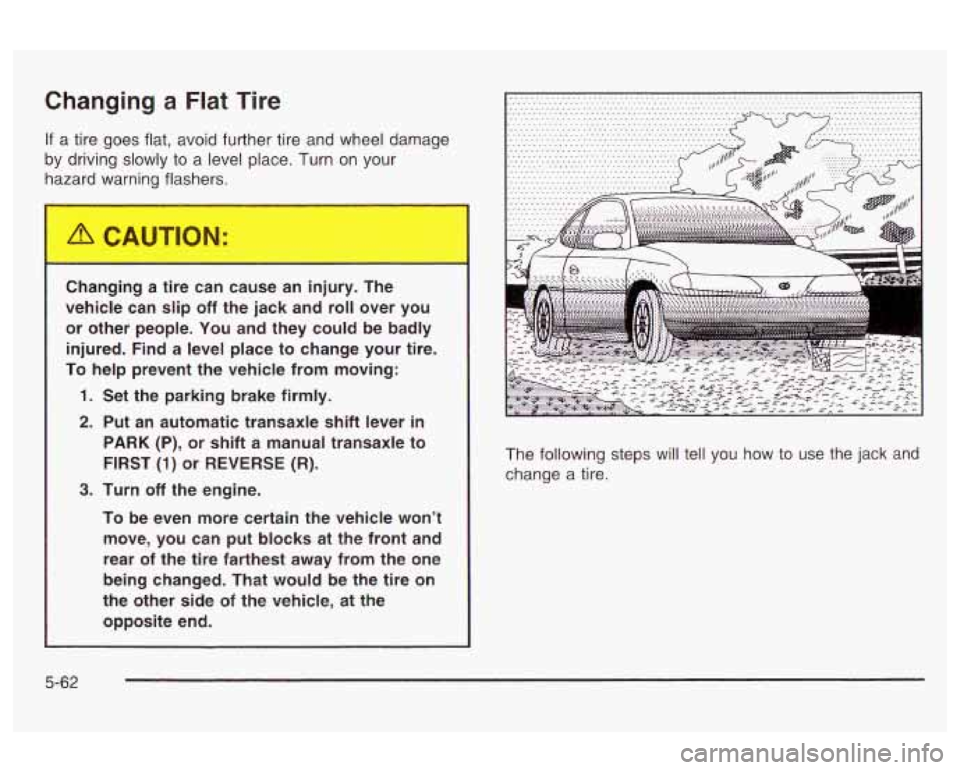
Changing a Flat Tire
If a tire goes flat, avoid further tire and wheel damage
by driving slowly to a level place. Turn on your
hazard warning flashers.
Changing a tire can cause an injury. The
vehicle can slip
off the jack and roll over you
or other people. You and they could be badly
injured. Find a level place to change your tire.
To help prevent the vehicle from moving:
1. Set the parking brake firmly.
2. Put an automatic transaxle shift lever in
PARK (P), or shift a manual transaxle to
FIRST
(1) or REVERSE (R).
3. Turn off the engine.
To be even more certain the vehicle won't
move, you can put blocks at the front and
rear
of the tire farthest away from the one
being changed. That would be the tire on
the other side
of the vehicle, at the
opposite end. The following
steps will tell you how to use the jack and
change a tire.
5-62
Page 287 of 354
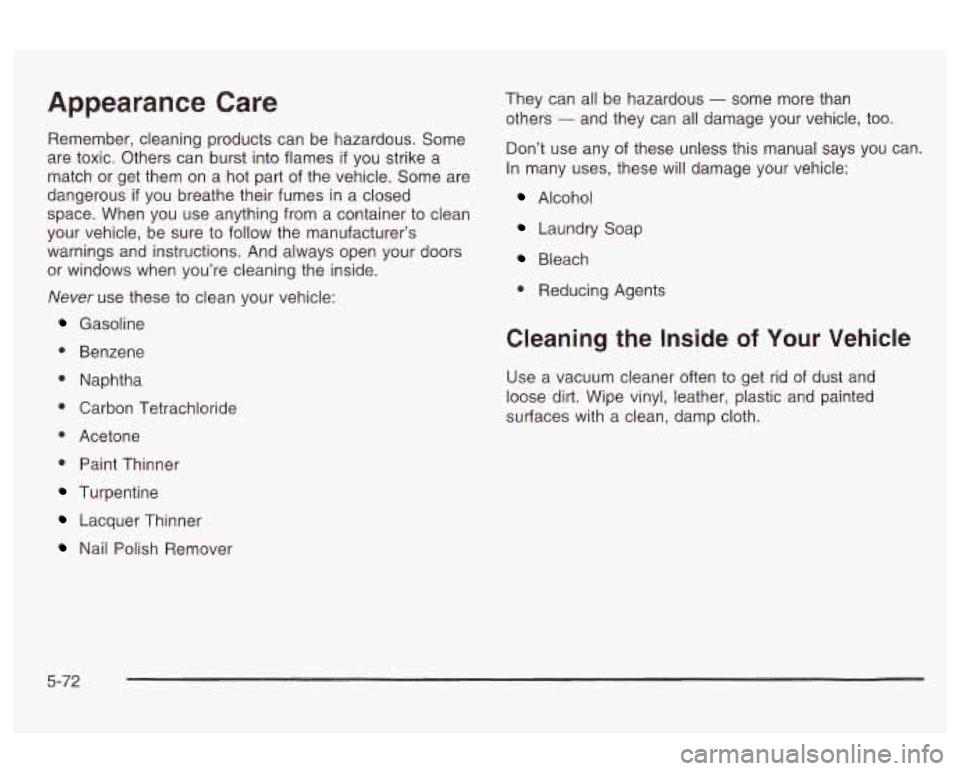
Appearance Care
Remember, cleaning products can be hazardous. Some
are toxic. Others can burst into flames
if you strike a
match or get them on a hot part
of the vehicle. Some are
dangerous
if you breathe their fumes in a closed
space. When you use anything from a container to clean
your vehicle, be sure to follow the manufacturer’s
warnings and instructions. And always open your doors
or windows when you’re cleaning the inside.
Never use these to clean your vehicle:
Gasoline
0 Benzene
0 Naphtha
0 Carbon Tetrachloride
Acetone Paint Thinner
Turpentine
Lacquer Thinner They can
all be hazardous
- some more than
others
- and they can all damage your vehicle, too.
Don’t use any of these unless this manual
says you can.
In many uses, these will damage your vehicle:
Alcohol
Laundry Soap
Bleach
0 Reducing Agents
Cleaning the Inside of Your Vehicle
Use a vacuum cleaner often to get rid of dust and
loose dirt. Wipe vinyl, leather, plastic and painted
surfaces with a clean, damp cloth.
Nail Polish Remover
5-72
Page 334 of 354
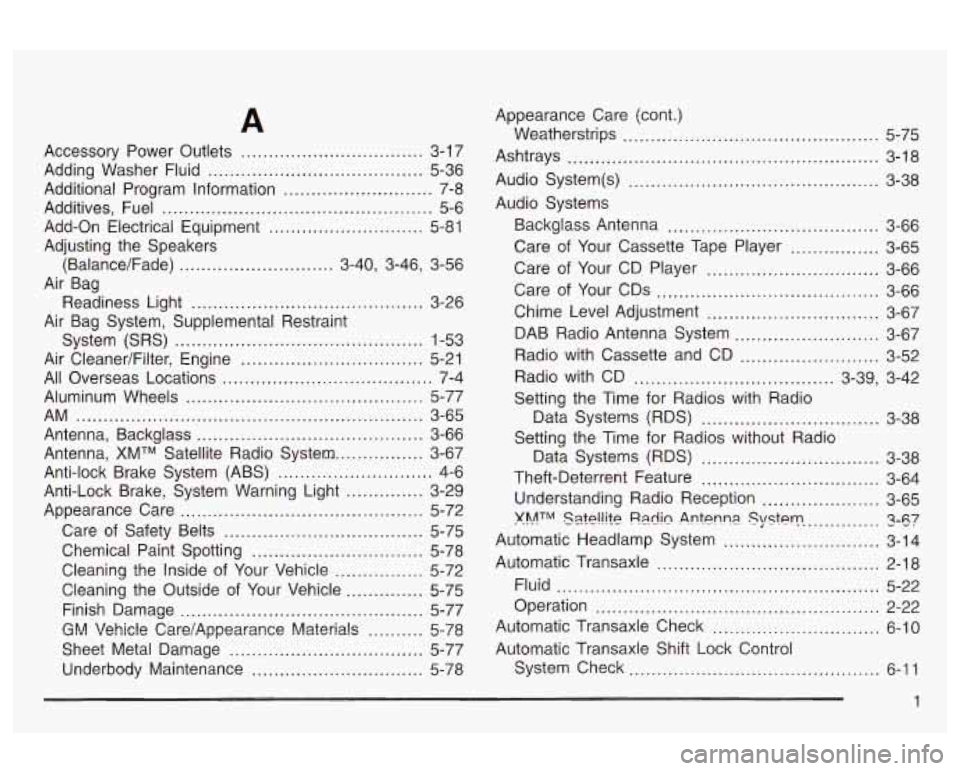
A
Accessory Power Outlets .............................. 3-17
Adding Washer Fluid
....................................... 5-36
Additional Program Information
........................... 7-8
Additives, Fuel
................................................. 5-6
Adjusting the Speakers
Air Bag
Air Bag System, Supplemental Restraint Add-On Electrical Equipment
............................ 5-81
(Balance/Fade)
............................ 3-40, 3-46, 3-56
Readiness Light
.......................................... 3-26
System (SRS)
............................................. 1-53
Air CleanedFiIter, Engine
................................. 5-21
All Overseas Locations ...................................... 7-4
Aluminum Wheels
........................................... 5-77
AM ................................................ ....... 3-65
Antenna, XMTM Satellite Radio System
................ 3-67
Anti-lock Brake System (ABS)
............................ 4-6
Anti-Lock Brake, System Warning Light
.............. 3-29
Care of Safety Belts
.................................... 5-75
Chemical Paint Spotting
............................... 5-78
Antenna, Backglass
......................................... 3-66
Appearance Care
............................................ 5-72
Cleaning the Inside of Your Vehicle
................ 5-72
Cleaning the Outside of Your Vehicle
.............. 5-75
Finish Damage
............................................ 5-77
G!.! Vehicle CarelAppearmce Materials .......... 5-78
Sheet Metal Damage ................................... 5-77
Underbody Maintenance
............................... 5-78 Appearance Care (cont.)
Weatherstrips
........... ........................ 5-75
Ashtrays
........................................................ 3-18
Audio System(s)
......................................... 3-38
Backglass Antenna
...................................... 3-66
Care of Your Cassette Tape Player
................ 3-65
Care of Your CD Player
............................... 3-66
Care of Your CDs
........................................ 3-66
Chime Level Adjustment
............................... 3-67
DAB Radio Antenna System
.......................... 3-67
Radio with Cassette and CD
......................... 3-52
Radio with CD
.................................... 3-39, 3-42
Setting the Time for Radios with Radio
Data Systems (RDS)
................................ 3-38
Setting the Time for Radios without Radio
Data Systems (RDS)
................................ 3-38
Theft-Deterrent Feature
................................ 3-64
Understanding Radio Reception
..................... 3-65
KhATM %?P!!ifP Radln Antenna . Sysf9t-p .............. 1-87
Automatic Headlamp System ............................ 3-14
Automatic Transaxle
........................................ 2-18
Fluid
.......................................................... 5-22
Operation
................................................... 2-22
Automatic Transaxle Check
.............................. 6-10
Automatic Transaxle Shift Lock Control
System Check
............................................. 6-11
Audio Systems
Page 335 of 354
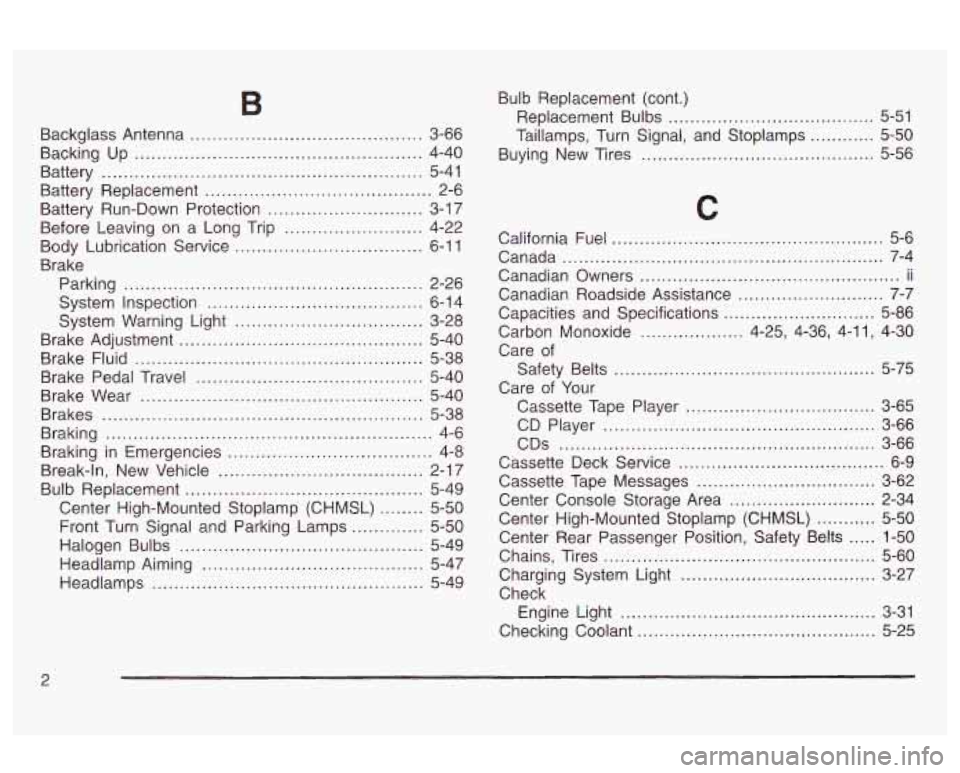
Backglass Antenna .......................................... 3-66
Backing Up
.................................................... 4-40
Battery
.......................................................... 5-41
Battery Replacement
......................................... 2-6
Battery Run-Down Protection
............................ 3-1 7
Before Leaving on a Long Trip
......................... 4-22
Body Lubrication Service
.................................. 6-1 1
Brake
Parking
................................... .... 2-26
System Inspection
.................... .... 6-14
System Warning Light
................... .... 3-28
Brake Adjustment
............................................ 5-40
Brake Fluid
.................................................... 5-38
Brake Pedal Travel
......................................... 5-40
Brake Wear
................................................... 5-40
Brakes
................................ ................... 5-38
Braking
................................... ................. 4-6
Break-in, New Vehicle
..................................... 2-17
Bulb Replacement
........................................... 5-49
Center High-Mounted Stoplamp (CHMSL)
........ 5-50
Front Turn Signal and Parking Lamps ............. 5-50
Headlamp Aiming .. .......................... 5-47
Braking
in Emergencies
............. ............. 4-8
Halogen Bulbs
............................................ 5-49
Headlamps
........ .......................... 5-49 Bulb
Replacement (cont.)
Replacement Bulbs
...................................... 5-51
Taillamps, Turn Signal. and Stoplamps ............ 5-50
Buying New Tires ........................................... 5-56
C
............
California Fuel ........................ ...... 5-6
Canada
......................................... .. 7-4
Canadian Owners
...............................
Canadian Roadside Assistance ........................... 7-7
Capacities and Specifications
............................ 5-86
Carbon Monoxide
................... 4.25. 4.36. 4-1 1. 4-30
Care
of
Safety Belts ........ ................ 5-75
Care of Your
..... II
Cassette Tape Player ... ................ 3-65
CD Player
.................................................. 3-66
Cassette Deck Service
...................................... 6-9
Center Console Storage Area
........................... 2-34
Center High-Mounted Stoplamp (CHMSL)
........... 5-50
Center Rear Passenger Position, Safety Belts ..... 1-50
Chains, Tires
.................................................. 5-60
Charging System Light
.................................... 3-27
Check Engine Light
............................................... 3-31
Checking Coolant
............................................ 5-25
CDS
.......................................................... 3-66
Cassette Tape Messages
................................. 3-62
3
Page 336 of 354

Checking Engine Oil ........................................ 5-15
Checking Things Under the Hood
....................... 5-9
Checking Your Restraint Systems
...................... 1-60
Chemical Paint Spotting
................................... 5-78
Child Restraints Child Restraint Systems
............................... 1-38
Infants and Young Children
........................... 1-34
Lower Anchorages and Top Tethers for Children (LATCH System)
.......................... 1-43
Older Children
............................................. 1-32
Securing a Child Restraint Designed for the
LATCH System
........................................ 1-45
Securing a Child Restraint in a Center Rear
Seat Position
........................................... 1-48
Securing a Child Restraint in a Rear Outside
Seat
Position ........................................... 1=45
Securing a Child Restraint in the Right Front
Seat Position
........................................... 1-50
Top Strap
................................................... 1-41
Where to Put the Restraint
........................... 1-41
Chime Level Adjustment
.................................. 3-67
wyC4i t;llt; Llyr ilGl 4- IO
Cleaning Inside of Your Vehicle
........................... 5-72
Outside of Your Vehicle
................................ 5-75
Underbody Maintenance
............................... 5-78
Weatherstrips
.............................................. 5-75
Cleaning Exterior LampdLenses ....................... 5-76
Top Strap Anchor Location ............................ 1-42
P: -.--- IL- I :-.LA-- A +n .............................................
Climate Control System ................................... 3-19
Outlet Adjustment
........................................ 3-22
Compact Disc Messages
................. 3-42, 3-52, 3-64
Compact Spare Tire
........................................ 5-71
Control of a Vehicle
.......................................... 4-5
Coolant Engine Temperature Gage
............................ 3-31
Heater, Engine
............................................ 2-20
Low Warning Light
....................................... 3-31
Cooling System
.............................................. 5-28
Cruise Control
................................................ 3-10
Cruise Control Light
........................................ 3-36
Current and Past Model Order Forms
................ 7-11
Customer Assistance Information
Courtesy Transportation
.........
Customer Assistance for Text
Telephone (TTY) Users
............................... 7-3
Customer Assistance Offices
........................... 7-3
Customer Satisfaction Procedure
..................... 7-2
GM Mobility Proaram for Persons with
Disabilities
................................................ 7-5
Reporting Safety Defects to General Motors
...... 7-9
Reporting Safety Defects to the
Canadian Government
................................ 7-9
Reporting Safety Defects to the
United
States Gzvernment .... ....... 7-9
Clutch, Hydraulic ............................................. 5-22
Cupholder(s)
.................................................. 2-34
.............. 7-7
3